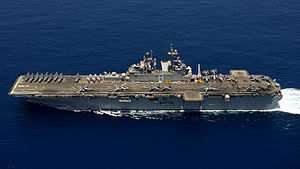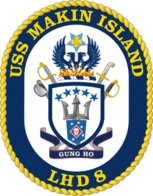USS Makin Island (LHD-8)
 USS Makin Island operating in the Indian Ocean during 2012 | |
| Career | |
|---|---|
| Name: | USS Makin Island |
| Namesake: | Makin Island |
| Awarded: | 19 April 2002[1] |
| Builder: | NGSS Pascagoula[1] |
| Laid down: | 14 February 2004[1] |
| Sponsored by: | Mrs. Silke Hagee, wife of Michael Hagee |
| Christened: | 19 August 2006 |
| Launched: | 22 September 2006[1] |
| Acquired: | 16 April 2009[2] |
| Commissioned: | 24 October 2009[3] |
| Homeport: | San Diego, CA[3] |
| Motto: | Gung Ho |
| Status: | in active service, as of 2015 |
| Badge: |
 |
| General characteristics | |
| Class and type: | Wasp-class amphibious assault ship |
| Displacement: | 41,649 tons full, 28,176 tons light, 12,821 tons dead[1] |
| Length: | 847 ft (258 m) overall, 778 ft (237 m) waterline[1] |
| Beam: | 118 ft (36 m) extreme, 106 ft (32 m) waterline[1] |
| Draft: | 27 ft (8.2 m) navigational, 28 ft (8.5 m) limit[1] |
| Installed power: | 2 × 35,000 hp gas turbines (GE - LM 2500+) 2 x 5,000 hp electric motors 6 × 4,000 kW diesel generators (Fairbanks Morse Engines) |
| Propulsion: | Hybrid electric propulsion driving two shafts 70,000 shaft horsepower (52 MW) 2 × 16.5 ft diameter controllable pitch propellers (Rolls Royce) |
| Speed: | 25 kn (46 km/h) |
| Range: | 9,500+ nmi. (17,600 km) at 20 knots |
| Boats and landing craft carried: | 3 × LCAC or 39 EFVs |
| Complement: | (typical) Embarked ship's company: 102 officers, 78 CPO/SNCO, 1,024 crew Embarked Marine detachment: 174 officers, 64 SNCO, 1,449 crew[1] |
| Armament: | 2 × Rolling Airframe Missile launchers, 2 × NATO Sea Sparrow launchers, 2 × 20 mm Phalanx CIWS mounts, 4 × 0.50 in machine guns, 3 × 25 mm Mk 38 autocannon, 1 × ceremonial gun |
| Aircraft carried: | (typical): Assault: 4 × CH-46 helicopters, Sea Control: 6 × AV-8B attack planes, 6 × ASW helicopters |
USS Makin Island (LHD-8), a Wasp-class amphibious assault ship, is the second ship of the United States Navy to be named for Makin Island, target of the Marine Raiders' Makin Island raid early on in the United States' involvement in World War II.
Construction
Makin Island 's task is to embark, deploy, and land elements of a Marine landing force in an Amphibious Assault by helicopters, landing craft, and amphibious vehicles. The secondary or convertible mission for Makin Island is that of sea control and power projection.
Makin Island is the eighth ship of the Wasp class, but she features noteworthy technological advances. Changes from the previous LHD design include: gas turbine main propulsion engines, all-electric auxiliaries, an advanced machinery control system including throttle control from the bridge, water mist fire protection systems, and the Navy’s most advanced command and control and combat systems equipment. The gas turbine propulsion plant, with all electric auxiliaries, is a program first for large deck amphibious assault ships and provides significant savings in manpower and maintenance costs associated with traditional steam-powered amphibious ships. The ship carries four reverse-osmosis water-purification systems, each capable of processing 50,000 gallons of fresh water per day.[4]
The same propulsion systems tried on the Makin Island will also be used on the America-class amphibious assault ships.[5]
History
Makin Island was laid down on 14 February 2004 by the Ingalls Shipbuilding, Pascagoula, Mississippi. She was christened on 19 August 2006, sponsored by Mrs. Silke Hagee, wife of General Michael Hagee, Commandant of the Marine Corps, and launched on 15 September 2006. In the aftermath of Hurricane Katrina, U.S. Navy officials announced that several ships under construction at Ingalls Shipbuilding had been damaged by the storm, including Makin Island and two Arleigh Burke-class destroyers. The ship's completion was delayed due to rewiring during 2008 to repair incorrect wiring installation.[4]
Makin Island was delivered to the U.S. Navy on 16 April 2009 and was commissioned at Pascagoula, Mississippi without ceremony on 26 June 2009 with Captain Bob Kopas in command.[3]
Makin Island deployed 10 July 2009 and sailed around South America via the strait of magellan, in which the crew continued to train, obtaining underway certifications in preparation for her arrival in San Diego. During the deployment, Makin Island conducted theater security cooperation (TSC) activities with Brazil, Chile and Peru, focusing on working closely with partner nation civil and maritime forces to share methods and training.[3] She arrived in her home port of San Diego on 14 September 2009. Captain Kopas stated in an interview on local radio that the Makin Island had saved about $2 million in fuel, compared with a conventional propulsion system, on her voyage from Mississippi around South America to San Diego.
Her formal commissioning ceremony took place on 24 October 2009 at Naval Air Station North Island, Coronado near San Diego.[2][6] Six USMC veterans of the Makin Island raid attended the ceremony.[7]
Damage to a turning gear delayed the ship's final check-out trials from August to September 2010.[8]
Makin Island visited San Francisco in October 2010 as part of the city's 2010 Fleet Week festivities.[9] She returned in 2012.[10]
The ship was used in a failed December 2014 US hostage rescue operation in Yemen.[11]
New propulsion
Makin Island departed on her maiden deployment, as the US Navy’s first hybrid-drive warship: part gas-turbine-electric and part diesel-electric.[12] About 70 percent of the time Makin Island can use diesel-electric propulsion, saving on fuel, as diesel engines are optimized for cruising and consume much less fuel than gas turbines. When she needs to travel quickly, at 12 knots or more, she uses her gas turbines.
Once on station, the ship’s mission changes. Her job then is to launch Marines ashore in small boats and aircraft. While the Marines are ashore, the ship maneuvers in a small area at slow speed, "the perfect scenario" for diesel-electric propulsion.
Fuel savings were said to be “impressive”. On an average day, the Makin Island uses 15,000 gallons of fuel, versus 35,000 to 40,000 gallons on an older steam ship of its type, said Captain James Landers, commanding officer.
The downside is the logistical “tail,” which means it takes a while to get parts. Further, the ship is software dependent, which is an independent source of failure.
Internal heating is provided by electrical instead of steam heaters and at temperatures above 20F there is excess heating capacity that can be reallocated for additional electric propulsion. The gas turbines are available for high speed or low temperature propulsion.[13]
References
- ↑ 1.0 1.1 1.2 1.3 1.4 1.5 1.6 1.7 1.8 "USS Makin Island (LHD 8)". Naval Vessel Register. U.S. Navy. Retrieved 2009-10-27.
- ↑ 2.0 2.1 "Navy Accepts Delivery of Future USS Makin Island". Navy News Service. Retrieved 17 April 2009.
- ↑ 3.0 3.1 3.2 3.3 "Makin Island Begins Transit to San Diego Homeport". Navy News Service. 11 July 2009. Retrieved 13 July 2009.
- ↑ 4.0 4.1 Liewer, Steve. "Navy Goes Green With New Hybrid Ship". San Diego Union-Tribune, 15 September 2009, p. 1.
- ↑ "Navy to Christen Amphibious Assault Ship America."
- ↑ "Navy USS Makin Island Official Page". Retrieved 24 October 2009.
- ↑ Liewer, Steve (24 October 2009). "Heroes Relive Epic Raid On Namesake Ship". San Diego Union-Tribune. p. B1.
- ↑ Steele, Jeanette (31 August 2010). "Navy's 'Green' Ship Delayed By Glitch". San Diego Union-Tribune.
- ↑ "Eco friendly USS Makin Island arrives in SF". ABC Local. 6 October 2010. Retrieved 8 October 2010.
- ↑ "USS Makin Island Arrives In San Francisco For 31st Annual 'Fleet Week'". US Navy. 3 October 2012. Retrieved 6 October 2012.
- ↑ "US forces raid al-Qaida hideout in Yemen; hostages reported killed". Stars and Stripes. Retrieved 6 December 2014.
- ↑ Steele, Jeanette (15 November 2011). "Navy's First Hybrid-Drive Warship Goes To Sea". San Diego Union-Tribune. Archived from the original on 15 March 2012.
- ↑ "USS Makin Island: Proven Fuel Efficient". MarineLink.com. Maritime Activity Reports, Inc. 23 January 2013.
External links
| Wikimedia Commons has media related to USS Makin Island (LHD-8). |
- Official website
- USS Makin Island page on globalsecurity.org
- USS Makin Island page on navsource.org
- USS Makin Island history page on USCarriers.net
| ||||||||||||||